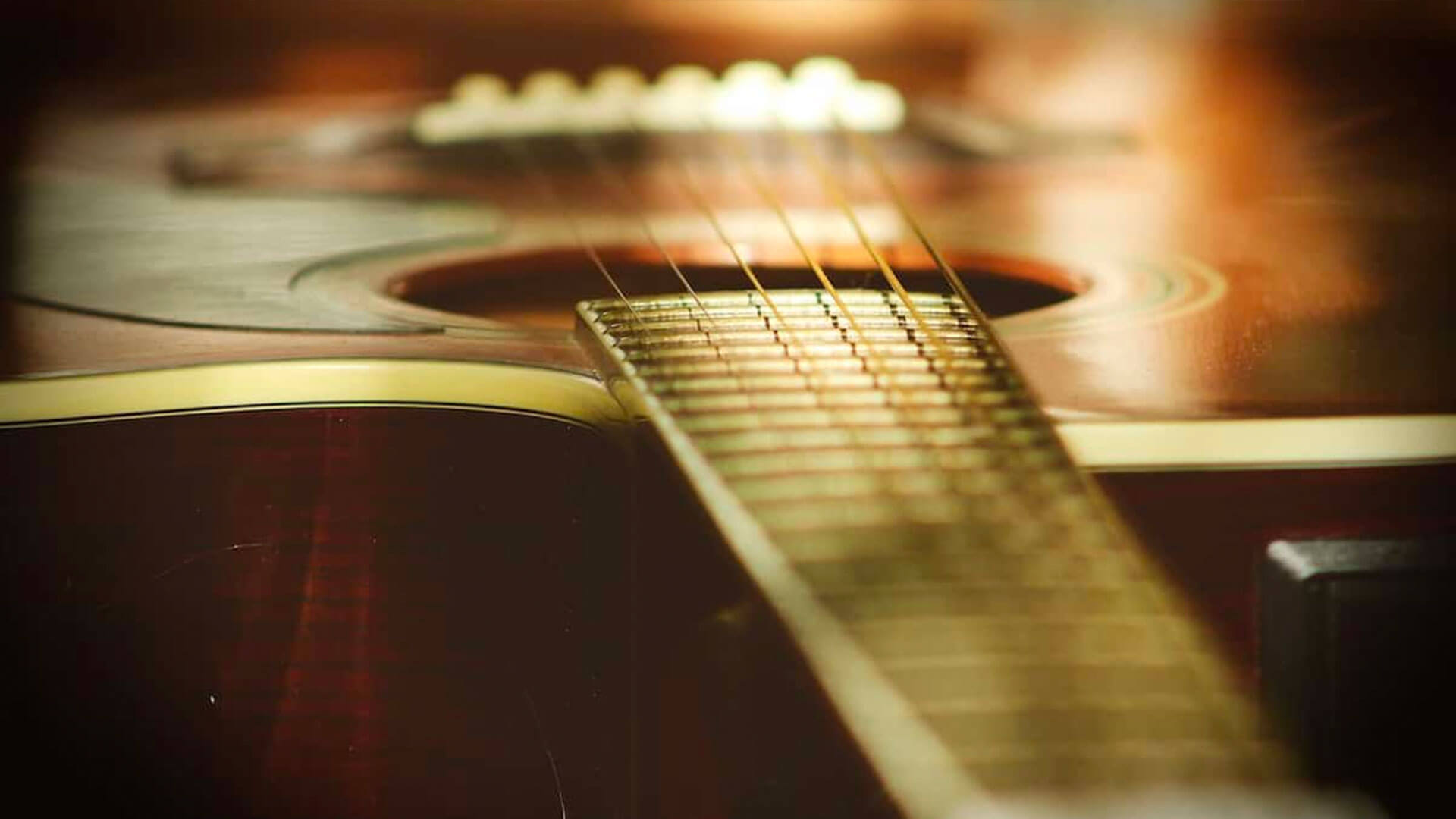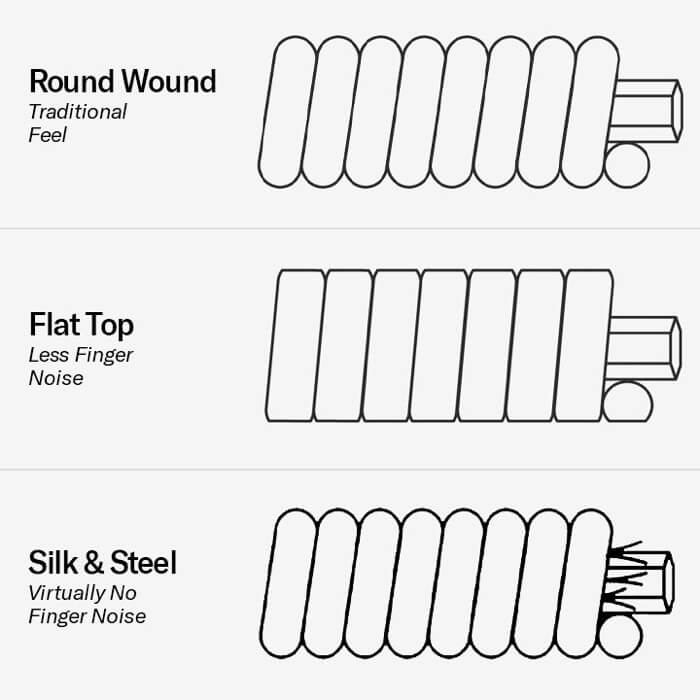The Ultimate Guide to Acoustic Guitar Strings

Not to diminish the importance of strings on an electric guitar, but with acoustic guitar strings, the marriage between strings and instrument is much closer and critical. With electric strings, their loss of tone over time is more gradual and not as immediately impactful on your guitar's tone (a tweak of your tone or gain knob might do the trick to liven things up), but an acoustic instrument's sound and performance can live or die by the strings on it. So, it's critical to understand not only the strings you are using, but also the condition they are in and how it can be affecting your instrument's sound and performance.
A Brief History of Acoustic Guitar String Materials
While the modern acoustic/classical guitar likely dates back to the 1850s, the development of the archtop acoustic guitar in the late 1800s by Orville Gibson changed everything. The importance of this advancement can't be overstated, particularly as it relates to string development. These guitars could handle more tension and therefore heavier gauged strings (primarily made of steel at the time – vs. nylon), which were now a requirement to achieve maximum volume and projection.
To accommodate this need for increased tension and volume, steel, copper, silver-plated copper, "commercial bronze" (90% copper and 10% tin and other alloys), and Monel (trade name for a nickel-copper alloy) all were used to varying degrees of success.
Then, sometime in the 1930s, John D'Addario Sr. met John D'Angelico. Both were New Yorkers who were part of a small, but growing musical instrument industry. By 1937 they had collaborated on pioneering not only standardized string gauges (light, medium, heavy, etc.), but more importantly, the use of a new alloy for strings which was ideal for the acoustic guitar. That alloy was 80/20 Bronze (though it's not really bronze, but more commonly known as brass), which is composed of 80% copper and 20% zinc.
The additional amount of zinc (vs. the aforementioned 90/10 commercial bronze) created a brighter, louder string than the traditional softer sounding alloys and harsher sounding steels. 80/20 brought out an impressive acoustic warmth, rich harmonics, and broader breadth of tone (more highs and lows), which became the standard for nearly four decades. Guitarists have these greats to thank in part for where we are today!
80/20 remained the standard until 1974 when Jim D'Addario first utilized phosphor bronze (92% copper, 7% tin and 1% phosphorous, sometimes referred to as 92/8) for guitar strings. Phosphor bronze offers an optimal balance between warmth and brightness while preserving string tone longer—you could call it the first extended life string. Today, phosphor bronze is the most popular acoustic string alloy and would be considered by most to be the standard.
Acoustic Friendly Materials
There are many acoustic-friendly materials available today that offer a variety of tonal options from warm to bright, increased lifespan, softer feel, unique tension options, etc. Here are a few popular options to consider:
Phosphor Bronze – As mentioned above, phosphor bronze offers an optimal balance between warmth and brightness while preserving string tone longer. Today, phosphor bronze is the most popular acoustic string alloy and would be considered by most to be the standard.
80/20 Bronze – The standard acoustic alloy for nearly four decades, 80/20 bronze provides a bright, shiny, and deep tone. Pioneered by John D'Addario Sr. and John D'Angelico, this alloy is ideal for players seeking a bright, vintage sound.
Silver Plated Copper – Traditional acoustic alloy with a base of copper plated with silver on top. Think about plated wrap wire as having a solid inner section with a thin outside sheath. SPC is warm and mellow, ideal for classical and folk style tone, but is prone to tarnishing quickly. Preferred for Classical guitar, Gypsy Jazz guitar and folk fingerstyle sounds.
Nickel Bronze – Nickel plating over phosphor bronze offers enhanced clarity, improved projection and improved string life. These strings are a great option for jazz, bluegrass, and a variety of other styles. The nickel bronze alloy projects the middle strings (D and G in particular) more in the mix and improves the volume balance between the wound and plain strings, all of which is great for single note lines and soloing.
Monel – Traditional acoustic alloy comprised of nickel (63-67%) and copper (27-34%) with traces of iron, carbon, manganese and silicon. Warm, "broken in" tone with fairly strong corrosion resistance.
Aluminum bronze – Aluminum and copper alloy offers enhanced clarity, volume and strong corrosion resistance.
85/15 – Another variant alloy composed of 85% copper, 15% zinc. Tonally, it subtly fits somewhere between Phosphor Bronze and 80/20, but is technically closer to 80/20 in most ways.
Stainless steel – While primarily an electric string alloy that lacks in acoustic warmth, some prefer stainless steel for its unique brightness, projection and long string life.
Nickel-plated steel – Believe it or not, similar to stainless steel fans, there are some who prefer electric strings on their acoustics. I know of several bluegrass flatpickers who swear by a set of D'Addario EJ22's (similar to a medium acoustic set) on their acoustics, claiming the strings allow the instrument to speak without the string coloring the inherent wood characteristics.
The bottom line is, it's good to experiment depending on what kind of string tone you prefer and how important string life is to you.
Coated or Uncoated Acoustic Guitar Strings?
Extended life and/or coated strings are a part of the arsenal for many players these days. This is particularly important for acoustic strings, which are much more susceptible to corrosion than electric strings.
The quality of coated strings today is pretty outstanding. Coating technologies and treatments have come a long way over the years, all with the player's needs and demands in mind. Delivering an uncoated string tone and comfortable feel (either natural or smooth, your preference) is mandatory in the string business today and there are many options to consider.
Acoustic String Construction
The vast majority of acoustic strings are round wound. This construction type delivers the most volume, resonance, and harmonic complexity. Volume and resonance are extremely important to an acoustic instrument as the strings are required to generate energy in order to produce sound.
While round wound is the standard for acoustic strings, there are other options and variants for different applications. Here are a couple of interesting construction options:
Flattops– a D’Addario innovation where they softly flatten the tops of a round wound phosphor bronze string. This is a similar effect as our Half Round electric strings, delivering a smoother feel and reduced finger noise. Some acoustic slide players and bluegrass flatpickers love these strings!
Silk and Steel– a silver-plated copper wrap wire is wound onto a steel core with inner windings of nylon filament material (no longer silk, technically, but the name has stuck over time). These strings are softer to the touch with less tension and a smoother feel than traditional acoustic strings. Ideal for some fingerstyle steel-string players who want more of a nylon/classical tone.

The last key topic surrounding acoustic guitar strings is gauge.
Today's wide variety of guitar body styles and shapes, wood types, musical styles, altered tunings, etc. creates the need for a multitude of gauge options. While standard gauges are pretty consistent for the masses (light, medium, heavy, etc.), there are more options than ever.
One thing to keep in mind is that even though there are general standards, there can be variations between brands in terms of how they name their gauges. Here are the D'Addario 6-string standards, but these might not always translate, so when shopping, make sure to look at the gauge numbers themselves, not just the gauge na

Extra Light 10-47This is a good gauge for beginners to get started with. It can also be great for recording. The lighter gauges compress well through microphones when strummed and create a smooth, even textured recorded acoustic sound.
Custom Light 11-52- This was Jim D'Addario's personal choice of gauges, so he created this custom set to his liking, hence Custom Light.
Light 12-53- The most popular selling acoustic string gauge. An ideal balance of comfort and volume. 12-53 gets the job done for most, but as one example of gauge variations between brands, some company's offer 12-54 as light gauge.
Light Top/Medium Bottom 12-56- Also known as the "Bluegrass" gauge since many flatpickers like to solo on lighter plain steel strings, but prefer the deep low end and volume of Medium gauge strings for rhythm playing. Good option for Drop D, as well.
Medium 13-56- Preferred for its increased volume and fullness. Not for the meek, these strings require more hand strength to realize and appreciate the benefits. Also, some players who tune down a ½ or whole step find this set useful.
Heavy 14-59- Only a small percentage of players go this heavy in standard tuning, but they are popular for down or altered tunings.
OK, that concludes our acoustic guitar string class for today...
Hopefully, you've learned something. While it seems like a lot, over time you just get it by trying things out and playing new styles. So, keep experimenting and, as always, have fun!



